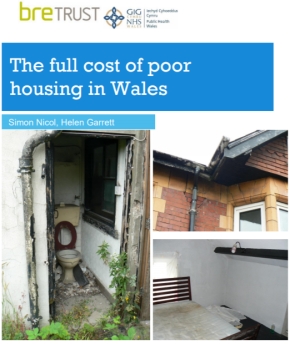The full cost of poor housing in Wales
The full cost of poor housing in Wales was written by Simon Nicol and Helen Garrett and published by the BRE Trust in 2019. It is intended to help to promote health and wellbeing, and make the case for better quality housing.
The report is an update of the original ’Cost of Poor Housing in Wales’ analysis using the latest profiles of housing conditions across Wales and updating the methodology in line with the more recent The Full Cost of Poor Housing report to reflect improved understanding of poor housing impacts.
It summarises the results of research commissioned by the BRE Trust, Public Health Wales (PHW) and the Welsh Government to provide estimates of the cost of poor housing to the NHS in Wales. It uses 2017 Welsh Housing Conditions Survey (WHCS) data and the revised annual NHS treatment cost methodology.
The key findings are:
- In 2017, the total number of dwellings with any Category 1 hazard (poor homes) in Wales was estimated to be 238,000, 18% of the total housing stock.
- The most common Category 1 hazards were those relating to falls in the home and the consequences of living in cold housing.
- The cost to reduce the hazards in these homes to an acceptable level is estimated to be £2,455 per home - a total cost of £584 million for the whole stock.
- If remedial works were undertaken up-front to mitigate these Category 1 hazards, it is estimated there would be a benefit to the NHS of £95 million per year.
- Remedial works to mitigate Category 1 hazards would pay for themselves in reduced NHS costs within 6 years. The costs of improving cold homes are some of the most expensive, but also the most effective in reducing costs to the NHS.
- These costs represent first year treatment costs to the NHS alone, following an accident or illness related to housing. The annual cost to the NHS represents around 10% of the full economic cost to society of leaving people in unhealthy housing in Wales, which is estimated at £1bn per year.
- The payback to society if all remedial work could be undertaken ‘up-front’ would be around six months.
You can download the report here.
[edit] Related articles on Designing Buildings Wiki
- A measure of net well-being that incorporates the effect of housing environmental impacts.
- BRE articles.
- Creating strong communities – measuring social sustainability in new housing development.
- Decent Homes for Ageing Well.
- Decent homes standard.
- Quantifying the health benefits of the Decent Homes programme FB 64.
- The cost-benefit to the NHS arising from preventative housing interventions (FB82).
- The cost of poor housing to the NHS.
- The full cost of poor housing.
- The Housing Stock of The United Kingdom.
- The real cost of poor housing.
- What's the condition of your housing stock?
Featured articles and news
UKGBC launch the UK Climate Resilience Roadmap
First guidance of its kind on direct climate impacts for the built environment and how it can adapt.
CLC Health, Safety and Wellbeing Strategy 2025
Launched by the Minister for Industry to look at fatalities on site, improving mental health and other issues.
One of the most impressive Victorian architects. Book review.
Common Assessment Standard now with building safety
New CAS update now includes mandatory building safety questions.
RTPI leader to become new CIOB Chief Executive Officer
Dr Victoria Hills MRTPI, FICE to take over after Caroline Gumble’s departure.
Social and affordable housing, a long term plan for delivery
The “Delivering a Decade of Renewal for Social and Affordable Housing” strategy sets out future path.
A change to adoptive architecture
Effects of global weather warming on architectural detailing, material choice and human interaction.
The proposed publicly owned and backed subsidiary of Homes England, to facilitate new homes.
How big is the problem and what can we do to mitigate the effects?
Overheating guidance and tools for building designers
A number of cool guides to help with the heat.
The UK's Modern Industrial Strategy: A 10 year plan
Previous consultation criticism, current key elements and general support with some persisting reservations.
Building Safety Regulator reforms
New roles, new staff and a new fast track service pave the way for a single construction regulator.
Architectural Technologist CPDs and Communications
CIAT CPD… and how you can do it!
Cooling centres and cool spaces
Managing extreme heat in cities by directing the public to places for heat stress relief and water sources.
Winter gardens: A brief history and warm variations
Extending the season with glass in different forms and terms.
Restoring Great Yarmouth's Winter Gardens
Transforming one of the least sustainable constructions imaginable.
Construction Skills Mission Board launch sector drive
Newly formed government and industry collaboration set strategy for recruiting an additional 100,000 construction workers a year.
New Architects Code comes into effect in September 2025
ARB Architects Code of Conduct and Practice available with ongoing consultation regarding guidance.
Welsh Skills Body (Medr) launches ambitious plan
The new skills body brings together funding and regulation of tertiary education and research for the devolved nation.
Paul Gandy FCIOB announced as next CIOB President
Former Tilbury Douglas CEO takes helm.



























